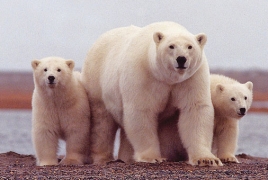 Born tiny, growing hugePolar bears - largest land carnivores International Polar Bear Day is an annual event celebrated every February 27. This day is organized by Polar Bears International to raise awareness about the impact of global warming and reduced sea ice on polar bear populations. The day encourages people to find ways to reduce their carbon output, such as by turning down their thermostat or driving less. The day has also been used to encourage the installation of energy efficient insulation in houses. PanARMENIAN.Net - English explorer and Royal Navy officer Constantine John Phipps was the first to describe the polar bear as a distinct species in 1774. Polar bears are the largest land carnivores in the world, rivaled only by the Kodiak brown bears of southwestern Alaska. Their fur is thicker than any other bears’ and covers even their feet for warmth and traction on ice. A thick layer of blubber beneath their fur provides buoyancy and insulation. The long neck and narrow skull of the polar bear probably aid in streamlining the animal in the water while warming the air that they breathe, and their front feet are large, flat and oar-like, making them excellent swimmers. According to DNA studies, polar bears have existed as a species for about 600,000 years Although polar bears appear white, their fur is actually transparent. It only appears white, because it reflects visible light. Under their fur, polar bear skin is actually black. An adult male polar bear typically weighs between 351 kg to 544 kg, or the weight of about five to seven men. The largest polar bear ever recorded was a male weighing about 1,000 kg. By contrast, adult females weigh only half as much as males, or 50 kg to 295 kg. Males reach their adult size between ages 8 and 14, while females reach full size between ages 5 and 6. Courtship and mating take place on the sea ice in April and May, when polar bears congregate in the best seal hunting areas. A male may follow the tracks of a breeding female for 100 km (60 mi) or more, and after finding her engage in intense fighting with other males over mating rights, fights that often result in scars and broken teeth. Polar bears have a generally polygynous mating system; recent genetic testing of mothers and cubs, however, has uncovered cases of litters in which cubs have different fathers. Partners stay together and mate repeatedly for an entire week. After mating, the fertilized egg remains in a suspended state until August or September. During these four months, the pregnant female eats prodigious amounts of food, gaining at least 200 kg and often more than doubling her body weight. But the bears are tiny when they're born, weighing only about 0,5 kg. The world’s oldest zoo polar bear to have lived was called Debby. She lived at Assiniboine Park Zoo in Winnipeg, Canada. She reached age 42, but was euthanized in November 2008 after it was discovered she was suffering organ failure. The World Conservation Union (IUCN) estimates that there are between 20,000-25,000 polar bears in the world. The range includes the territory of five nations: Denmark (Greenland), Norway (Svalbard), Russia, the United States (Alaska) and Canada. These five nations are the signatories of the International Agreement on the Conservation of Polar Bears, which mandates cooperation on research and conservation efforts throughout the polar bear's range. The temperatures the polar bears have to endure can range from -40°C to -90°C in the winter. The summer months can be much warmer, reaching 25°C. Polar bears thrive in the cold, spending a great deal of their time in the Arctic Ocean to hunt and search for food. If a polar bear doesn't eat for seven to 10 days, it can slow its metabolism until it finds its next meal. They survive off of fat reserves from their diet, which consists mostly of ringed and bearded seals. However, climate change is making food more scarce and driving some bears to cannibalism. The chief threat to the polar bear is the loss of its sea ice habitat due to global warming. As suggested by its specific scientific name (Ursus maritimus), the polar bear is actually a marine mammal that spends far more time at sea than it does on land. It is on the Arctic ice that the polar bear makes its living, which is why global warming is such a serious threat to its well-being. As climate change melts sea ice, the U.S. Geological Survey projects that two thirds of polar bears will disappear by 2050. Without action on climate change, scientists predict we could lose wild polar bears by 2100. The retreat of ice has implications beyond the obvious habitat loss. Remaining ice is farther from shore, making it less accessible. The larger gap of open water between the ice and land also contributes to rougher wave conditions, making the bears’ swim from shore to sea ice more hazardous. In 2004, biologists discovered four drowned polar bears in the Beaufort Sea, and suspect the actual number of drowned bears may have been considerably greater. Never before observed, biologists attributed the drowning to a combination of retreating ice and rougher seas. Lusine Mkrtumova / PanARMENIAN.Net How collection of horned creatures turned into museum New York’s first female crime boss World’s largest boneyard An Italian photojournalist’s journey through the pandemic Quarantine in metropoles Town without newborns and dead Nine months in the Pacific |